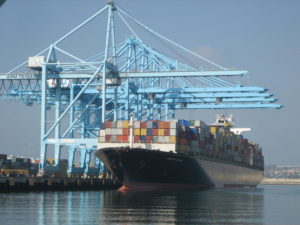Panama Canal Impacts Logistics, Real Estate and the Global Supply Chain
The global economy is fascinating to me, particularly the supply chain, logistics and how goods are moved across the planet. I’ve followed this since writing two articles in 2009 and 2010 for Urban Land magazine. Now that the expanded Panama Canal is complete (in 2016), allowing significantly larger container ships through, what are the impacts on global trade and real estate? Research departments at the large real estate firms are already speculating, and reporting some shifts in activity.
Most consumer goods imported from across the Pacific are unloaded at west coast ports, and containers are loaded on trains and/or trucks for their journeys across the U.S. The Panama Canal expansion allows all but the largest container ships through to Gulf and East Coast ports. This is already changing shipping patterns and real estate opportunities.
Just this week, JLL published an article looking at increased demand for distribution centers near east coast ports. JLL cites a study by the Boston Consulting Group and C.H. Robinson indicating a potential 10% shift in traffic from the west to east coast. That could have vast implications and ought to keep demand strong for industrial space near intermodal hubs.
Colliers International’s annual “Big Box” report looks at the market for large warehouses in major markets like Atlanta, Chicago, Dallas, Los Angeles and New York/New Jersey. As of the end of 2016, demand for space was strong, driven by e-commerce and the need for newer and larger fulfillment centers in major metros. The next annual report ought to shed some light on changes brought by the canal expansion.
An end of 2016 Cresa report also considered the impact of larger ships in the Panama Canal. In advance of the increased canal capacity, several ports like Savannah have undertaken significant upgrades, including larger cranes and deeper harbors. Ultimately, Cresa determined that the impact of the canal won’t be fully understood for years.
The JLL 2017 Seaport Report highlights trends like the last mile, in which, as a result of more fulfillment centers being built closer to customers, the ratio of inventory to sales has increased. This is due to trends in e-commerce, where the winners are warehouse space owners and developers and the losers are bricks-and-mortar retail stores. This is a trend occurring regardless of the canal expansion.
The other issues covered by the JLL Seaport Report and carefully monitored by others is the status of any changes to the U.S. tax code and the future of NAFTA. If trade with Mexico declines as a result of changes to NAFTA, second-tier markets may be most exposed. Already, protectionism is starting to influence companies’ supply chains, something that will have to be watched carefully.
The impacts of the Panama Canal will be studied for years to come, and as this week’s JLL article notes, best leveraging the expanded canal is a “complex calculation.” In the meantime, ports that have moved ahead with infrastructure improvements are best suited to take advantage of the enlarged Panama Canal capacity. Population centers with the best transportation access from these ports could well see the most distribution/fulfillment center growth. E-commerce will continue to drive changes to warehousing and delivery. The most cloudy of the crystal balls are impacts of legislative changes coming out of Washington D.C. But it sure is fascinating to watch.
(Of course, logistics can also save lives, as we are seeing in Puerto Rico.)
No Comments »
No comments yet.
RSS feed for comments on this post. TrackBack URI
Leave a comment
Line and paragraph breaks automatic, e-mail address never displayed, HTML allowed: <a href="" title=""> <abbr title=""> <acronym title=""> <b> <blockquote cite=""> <cite> <code> <del datetime=""> <em> <i> <q cite=""> <s> <strike> <strong>

